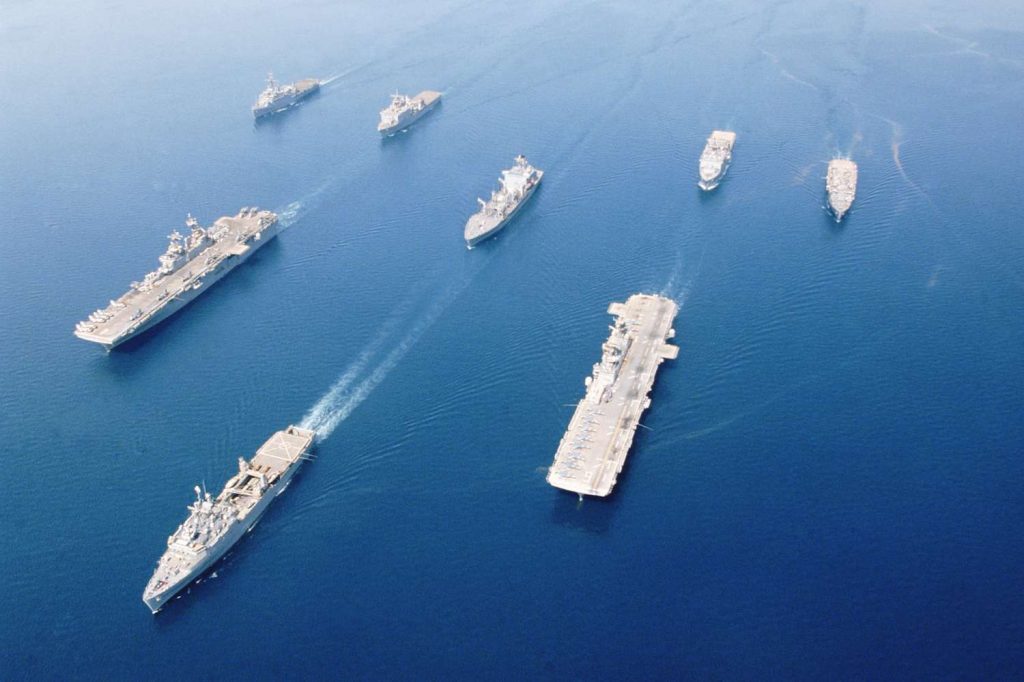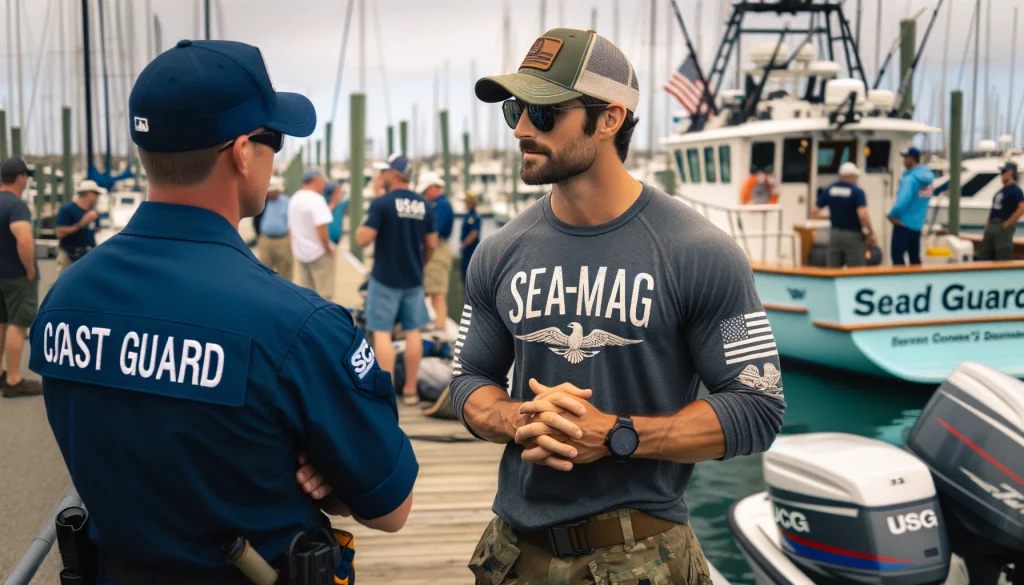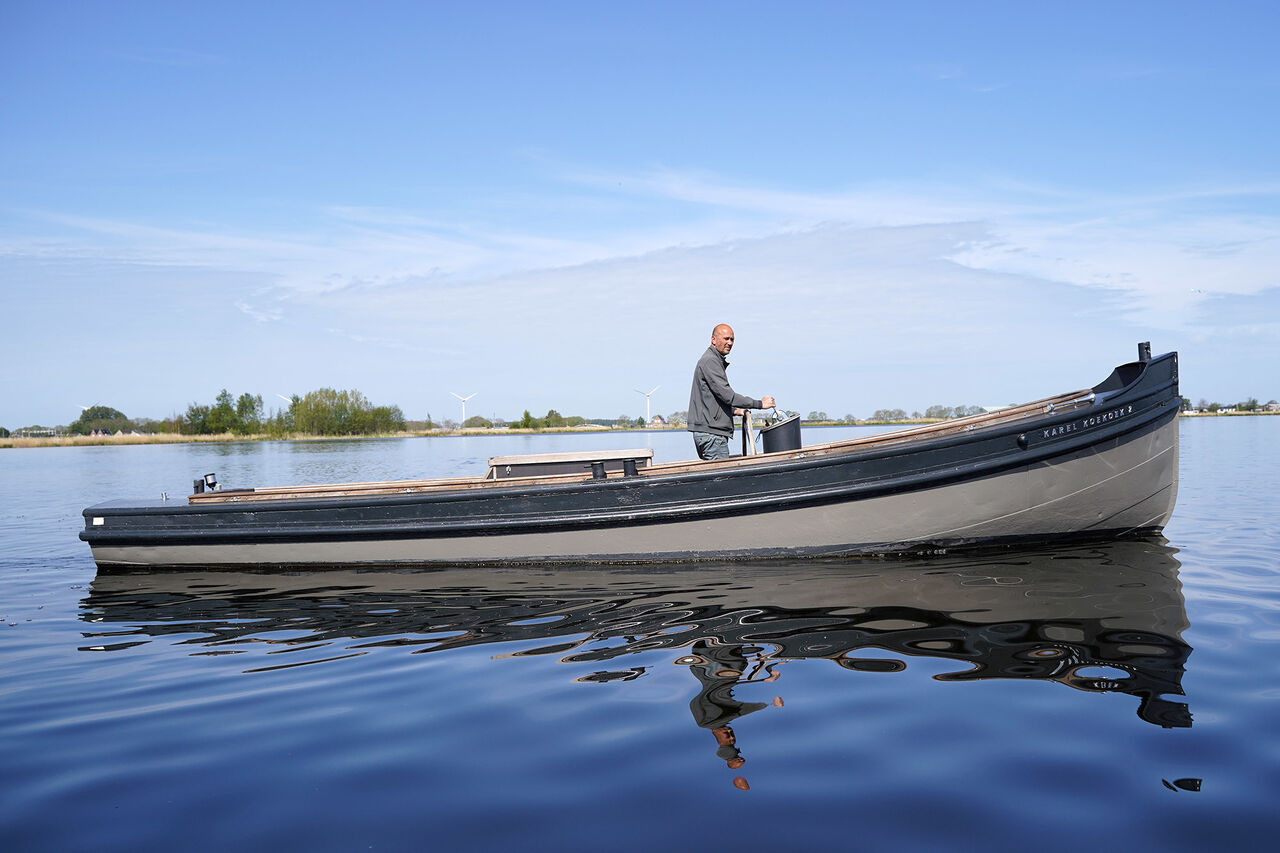What Minimum Distance Must be Maintained from a U.S. Naval Vessel? Safety Guidelines Explained
Navigating the waters near U.S. naval vessels requires an understanding of the rules and regulations established to ensure the safety and security of both military and civilian maritime traffic.
One crucial aspect of these regulations involves maintaining a minimum distance from naval vessels when passing by or operating in their vicinity.

By adhering to these guidelines, boaters can avoid potential hazards and contribute to the overall security of our waterways.
The minimum distance mandated by the U.S. Coast Guard for approaching naval vessels is 100 yards.
While all vessels must maintain this buffer, particular attention is given to recreational boaters, who are specifically advised to operate at minimum speed within 500 yards of a U.S. naval vessel.
Violations of these requirements may result in severe penalties, including fines and imprisonment, which underscore the importance of adhering to these directives.

Key Takeaways
- Maintain a minimum distance of 100 yards from U.S. naval vessels
- Operate at minimum speed within 500 yards of naval vessels
- Violations of these distance requirements may result in severe penalties
Understanding Naval Vessel Protection Zones
For the safety and security of U.S. naval vessels, the United States Coast Guard (USCG) has established a Naval Vessel Protection Zone (NVPZ) around large U.S. naval vessels.
These zones are designed to provide a safe distance between the general public and military ships, ensuring that both parties can navigate the waterways without posing a risk to one another1.
NVPZs exist around U.S. naval vessels greater than 100 feet in length overall, regardless of whether the ship is underway, anchored, moored, or within a floating dry dock2.
There are, however, a few exceptions to these zones. Large naval vessels moored or anchored within a restricted area or naval defensive sea area are not subject to NVPZs3.
Maintaining a minimum distance of 500 yards from a U.S. naval vessel within an NVPZ ensures the safety and security of both the vessel and civilians4.

When operating within this zone, boaters must also:
- Operate at the minimum speed necessary to maintain a safe course
- Proceed as directed by the naval vessel's Commanding Officer or the USCG1
Local authorities and Homeland Security play a vital role in monitoring the activities around naval vessels, ensuring that civilians adhere to the guidelines set forth by the USCG5.
Violations of an NVPZ may be considered a felony offense, punishable by up to six years in prison and/or fines up to $250,0001.
Legal Requirements for Approaching Naval Vessels
Minimum distance is a crucial aspect when approaching a U.S. naval vessel.
Regulations specify that one should not approach within 100 yards of a U.S. naval vessel.
In addition, a minimum speed must be maintained within 500 yards of any U.S. naval vessel. These restrictions apply to both recreational boaters and commercial vessels.
The U.S. Coast Guard (USCG) enforces these requirements to ensure the safety and security of naval vessels in navigable waters.
Law enforcement officials, including the Coast Guard, play a vital role in monitoring and penalizing violations of these regulations.
It's essential for all boaters to be aware and respectful of these legal requirements when operating near naval vessels.
Violations of the Naval Vessel Protection Zone are considered a felony offense and can lead to severe consequences.
Punishments may include up to 6 years in prison and/or up to $250,000 in fines.
Key Points:
- Do not approach within 100 yards of a U.S. naval vessel.
- Maintain minimum speed within 500 yards of any U.S. naval vessel.
Exceptions to these regulations may be granted under certain circumstances.
For example, if a vessel needs to pass within 100 yards for safe passage, the vessel operator must first contact the Coast Guard or the naval vessel's commanding officer for authorization.
Operational Guidelines for Boaters
The safety and security of U.S. naval vessels and their surrounding waterways are of paramount importance. For this reason, boaters must adhere to specific guidelines and maintain a safe distance from these naval vessels while navigating through waters.
First and foremost, a boater must maintain a minimum distance of 100 yards from any U.S. naval vessel at all times. This rule applies to both recreational boaters and commercial vessels, and is part of the Naval Vessel Protection Zone regulations. Although exceptions can be made for safe passage, boaters must obtain authorization from the official patrol.
As for speed, when operating within 500 yards of a U.S. naval vessel, boaters are required to reduce their speed to the minimum necessary to maintain a safe course. This decrease is crucial to avoid accidents and to keep the waterways safe for other vessels in the area.
In addition to adhering to these distance and speed guidelines, boaters should also follow established navigation rules, also known as "rules of the road."
These navigation rules play a significant role in promoting safety and avoiding accidents on the water. Boaters should familiarize themselves with the appropriate right-of-way in different situations, understand how to use various navigation lights and signals, and know when to give way or stand on when encountering other boats.
Further, boaters are encouraged to be familiar with proper anchor usage when near naval vessels. Keeping away from restricted areas will significantly reduce the chances of unintentional encroachment and ensure the safety of their boat and others in the vicinity.
Lastly, boaters should maintain a sharp eye and stay vigilant while navigating around naval vessels. Maintaining situational awareness, being mindful of other vessels, and following all safety guidelines are crucial to keeping waterways safe and secure.
Security Measures and Restrictions
The U.S. government has implemented strict security measures around naval vessels to protect them from potential threats. These measures include maintaining a minimum distance from U.S. naval vessels and following specific rules in place for the safety and security of all watercraft in the area.
Reporting Suspicious Activities
If you witness any suspicious activities or behavior around a U.S. naval vessel, it is vital to report it immediately to the appropriate authorities. Observing and avoiding all security zones are important actions that boaters and mariners must undertake. You can quickly report any questionable activities by contacting the U.S. Naval vessel or the USCG escort vessel on VHF-FM channel 16.
Compliance With Local Waterway Regulations
- Maintaining a Safe Distance: Boaters should never approach within 100 yards of any U.S. naval vessel and must slow to minimum speed within 500 yards. Violations of the Naval Vessel Protection Zone are a felony offense, punishable by up to 6 years in prison and/or up to $250,000 in fines.
- Restricted Areas: Avoid restricted areas such as commercial port zones, especially those containing military, cruise-line, or petroleum facilities. Do not stop or moor beneath bridges or in the channel.
- Marine Patrols: Marine patrols may enforce security zones and local waterway regulations. Boaters should always be prepared to accommodate their instructions and follow any additional navigation rules they present.
- Securing Your Vessel: It is essential to secure your vessel when not in use. Locking doors, hatches, and windows can help prevent unauthorized access and potentially harmful situations.
Communication Protocols and Emergency Procedures
Communication protocols and emergency procedures are essential for maintaining a safe distance from U.S. naval vessels. Operators of watercraft must be aware of these requirements and follow them to ensure the safety and security of both their vessel and the naval vessel in question.
One of the primary communication channels for maritime emergencies is the VHF-FM channel 16. This frequency should be used to contact authorities, such as the Coast Guard1, in case of any emergency or when in doubt about the proper distance from a naval vessel. Additional resources can also be found on the USCG website.
Watercraft operators should be aware of the importance of using visual distress signals when in distress. These signals can include flares, smoke, flags, or other internationally recognized distress signals. It is crucial to remain vigilant and prepared for any potential emergency situation, as limited resources may be available in certain areas.
To ensure the safety of everyone on board and in compliance with regulations, all occupants of a watercraft must wear a life jacket. Life jackets not only provide buoyancy during emergencies but also help coast guards and other rescuers identify and locate individuals in the water more easily2.
Operating at a minimum safe speed within 500 yards of any U.S. naval vessel is required, as well as following the instructions given by the Commanding Officer or official patrol3. Violations of the Naval Vessel Protection Zone could lead to severe consequences, including imprisonment and fines.
Footnotes
- https://www.navcen.uscg.gov/?pageName=mtNds ↩
- https://www.safeboatingcampaign.com/resources/life-jackets/ ↩
- https://homeport.uscg.mil/Lists/Content/Attachments/1924/NVPZflyer.pdf ↩
Safety Precautions Near Critical Infrastructure
When navigating around critical infrastructure such as U.S. naval vessels, petroleum facilities, dams, power plants, and bridges, it is vital to maintain a safe distance and adhere to any designated protection zones.
Understanding these regulations is essential in ensuring the safety and security of those operating within these areas.
For U.S. naval vessels, boaters must operate at a minimum speed within 500 yards and maintain a distance of at least 100 yards from the vessel.
Violations of the Naval Vessel Protection Zone can result in significant fines and even imprisonment.
It is important to observe these zones not only for the safety of the vessel's crew but also for the security of the vessel itself.
When approaching petroleum facilities, operators should also stay clear of designated buffer zones and maintain a safe distance from any visible infrastructure.
These parameters help prevent accidents, spills, or sabotage attempts that could lead to environmental damage or a loss of critical resources.
Dams and power plants play a crucial role in providing energy and controlling water flow, making them vital components of the nation's infrastructure.
Boaters must avoid restricted areas surrounding these facilities, as coming into close proximity can pose a security risk or disrupt operations.
Additionally, the waterways near dams often have strong currents or turbulent waters, requiring extra caution from boaters.
In the case of bridges, limitations may be in place due to height restrictions, security measures, or construction activities.
It is important for boaters to become familiar with these restrictions before approaching a bridge, as many restricted waters are not marked on local charts.
When encountering any out of the extraordinary situations or seeing anything suspicious, boaters should immediately contact the appropriate authorities, such as the U.S. Coast Guard or local law enforcement, to report the situation.
This helps ensure the safety and security of critical infrastructures throughout the nation's waterways.
Interaction With Military and Commercial Shipping
When operating a boat or vessel, it is crucial to be aware of the presence of military, cruise line, and commercial shipping in the surrounding waterways.
Maintaining a safe distance from these vessels is important for both security and navigational purposes.
U.S. naval vessels have specific regulations pertaining to their security and protection.
Recreational boaters must not approach within 100 yards of a U.S. naval vessel, and they must slow down to a minimum speed within 500 yards of the vessel.
Violators of the Naval Vessel Protection Zone can face consequences such as 6 years in prison and up to $250,000 in fines.
In addition to military vessels, it is essential to maintain appropriate distances from cruise lines and commercial shipping like cargo ships and container vessels.
As a general rule, a distance of 100 yards should be kept from these vessels, and it is especially important to be cautious when navigating in the vicinity of commercial port operation areas.
High traffic and large vessel size can make maneuvering difficult, which may lead to accidents or injuries.
Port operations and the presence of commercial ships can also pose risks in the form of congestion, hazardous cargo, and strict security regulations.
To ensure smooth sailing, boaters should familiarize themselves with the areas in which they are navigating, paying special attention to the following key aspects:
- Coast Guard regulations and local navigation rules
- Shipping lanes and other high-traffic areas
- Designated channels and anchorage sites
Guidelines for Safe and Secure Passage
Recreational boaters play a crucial role in maintaining the safety and security of waterways near U.S. naval vessels. It is essential for operators to be aware of the proper protocol for passing these vessels when underway.
The following guidelines can help ensure that boaters maintain a safe and secure passage around U.S. naval vessels.
First and foremost, boaters must not approach within 100 yards of any U.S. naval vessel.
To further ensure safety, operators are required to slow down to minimum speed within 500 yards of the naval vessel.
These measures are in place to prevent accidents, collisions, or disruptions to the vessel's operations.
In some cases, the prescribed distance of 100 yards may not be feasible due to navigational constraints.
In such situations, boaters must request permission to pass within the restricted zone.
To do this, operators should contact the U.S. naval vessel or the Coast Guard escort vessel on VHF-FM channel 16.
Communication is essential to ensure both parties are aware of the situation and can coordinate their actions accordingly.
Boaters must be vigilant in adhering to these guidelines to ensure their own safety as well as the safety of the naval vessel and its crew.
Consequences of Non-Compliance
Maintaining a safe distance from U.S. naval vessels is not only a matter of safety, but also a legal requirement. Violating these restrictions can result in serious consequences.
This section discusses the potential outcomes for those who fail to comply with the regulations, taking into account the relevant authorities, penalties, and enforcement actions.
It is crucial to understand that operating a vessel within 500 yards of any U.S. naval vessel requires maintaining minimum speed.
Failure to comply with this rule may lead to a felony offense, such as fines and imprisonment.
Should the Commanding Officer or official patrol issue further directions, individuals must follow these instructions to avoid punishment.
Violating the Naval Vessel Protection Zone carries significant legal penalties.
Specifically, offenders may face up to six years in prison and/or fines of up to $250,000.
This reflects the importance placed on the safety and security of U.S. naval vessels and their personnel.
In addition to potential fines and imprisonment, failure to maintain the required distance from a U.S. naval vessel can result in an immediate and severe response from the vessel's security team.
This further emphasizes the importance of being aware of and adhering to the established restrictions.
Frequently Asked Questions
How close can a civilian boat get to a U.S. Navy ship?
Civilian boats are advised to maintain a safe distance from U.S. naval vessels. Specifically, do not approach within 100 yards and slow to minimum speed within 500 yards of any U.S. naval vessel.
What is the legally required distance to keep from a naval vessel when on the water?
Legally, a civilian boat must not approach within 100 yards of a U.S. naval vessel and should reduce speed to the minimum within 500 yards of the vessel.
What actions are necessary when boating within 500 yards of a naval vessel protection zone?
When within 500 yards of a naval vessel, operate at minimum speed and proceed as directed by the vessel's Commanding Officer or the official patrol. In case you must pass within 100 yards for safe passage, obtain clearance from the naval vessel.
Are there specific rules for navigating around military ships at sea?
Yes, there are specific rules when navigating around military ships. Keep a distance of at least 100 yards, and slow to minimum speed within 500 yards of any U.S. naval vessel. Follow the directions of the Commanding Officer or the official patrol to avoid incidents.
What penalties are imposed for violating the naval vessel protective zone?
Violating the Naval Vessel Protection Zone is a felony offense. It is punishable by up to 6 years in prison and/or up to $250,000 in fines.
What safety precautions should be taken when sailing in the vicinity of a U.S. naval fleet?
To ensure safety, maintain a minimum distance of 100 yards from U.S. naval vessels. Slow to minimum speed within 500 yards, and follow the directions given by the Commanding Officer or the official patrol.

Q&A With USCG
Charlie: Good afternoon, Steve. Thank you for joining us today. Our readers are eager to learn more about the distance that must be maintained from a US Naval Vessel. Can you start by explaining the basic regulations?
Steve: Good afternoon, Charlie. Absolutely, maintaining a safe distance from a US Naval Vessel is crucial for both safety and security. The required distance is generally 100 yards. If you need to approach within 100 yards, you must contact the vessel or the Coast Guard on VHF channel 16 to obtain permission. Failure to comply can result in a quick and severe response from law enforcement.
Charlie: That's important to know. Can you elaborate on the types of safety equipment that must be carried onboard vessels operating near naval vessels?
Steve: Certainly. All vessels, whether recreational or commercial, must adhere to certain safety equipment regulations. This includes having sound producing devices required for communication, life jackets, fire extinguishers, and sound signaling appliances capable of making appropriate signals. It's also recommended to have your recreational vessel inspected through a vessel safety check, which can be arranged via the Coast Guard Auxiliary website or the United States Power Squadrons.
Charlie: What role does the Coast Guard Auxiliary play in maintaining port or marina security?
Steve: The Coast Guard Auxiliary plays a vital role in port and marina security. They conduct vessel safety checks, educate boaters through boating safety courses, and ensure that recreational boats comply with state and federal regulations. They also assist in law enforcement boarding and can provide immediate boarding if needed.
Charlie: Can you tell us more about the boating safety certificate and how it is obtained?
Steve: A boating safety certificate is obtained by completing a boating safety course offered by state boating agencies, the Coast Guard Auxiliary, or the United States Power Squadrons. These courses cover essential topics such as navigation rules, safety equipment required, and emergency procedures. Once you complete the course, you receive a boating safety certificate, which is valid and should be carried onboard vessels operating.
Charlie: What are some of the regulations concerning hazardous waste disposal and oil spill response vessels?
Steve: Boaters must adhere to both state hazardous waste regulations and federal guidelines for the correct disposal procedures of hazardous materials. Oil spill response vessels are specially equipped to handle spills and prevent environmental damage. It's crucial to find boating laws applicable in your area and ensure compliance to avoid penalties.
Charlie: How do recreational vessel operators find the boating laws applicable to their specific state or region?
Steve: Boating laws can be found on the state boating authority's website or by contacting the state boating agency. Additionally, the Coast Guard Auxiliary website and the vessel safety check website provide valuable resources. It's important for boaters to stay informed about state and federal regulations to ensure boating safety and avoid violations.
Charlie: What measures should be taken when operating near commercial port operation areas and commercial ships?
Steve: When operating near commercial port operation areas and commercial ships, it's essential to maintain a safe distance and avoid anchoring beneath bridges or in restricted areas. Approaching commercial vessels requires caution, as these ships have limited maneuverability. Always follow marina security protocols and communicate with port authorities when necessary.
Charlie: Can you explain the role of the marine safety center's tonnage in recreational boating?
Steve: The marine safety center's tonnage regulations ensure that vessels are properly classified based on their size and capacity. This affects safety equipment requirements and the type of certification needed. Recreational vessels must adhere to these regulations to ensure they are operating safely and legally.
Charlie: Finally, how does one go about scheduling a vessel safety check, and what does it entail?
Steve: Scheduling a vessel safety check is simple. You can contact a volunteer vessel examiner through the Coast Guard Auxiliary or visit their website. The safety check includes an inspection of safety equipment, verification of boating safety certificates, and ensuring compliance with state and federal regulations. It's a free service aimed at promoting boating safety and preventing accident.
Sorry we're running short on time, in our next discussion we will cover the following:
boating safety certificate valid
anchor beneath bridges
platform and body surf
state boating authority
coast guard documented
recreational boat
state's boating authority
sound signaling appliance capable
possibly severe response
involve military
Charlie is Editor-in-Chief of Sea Magazine







